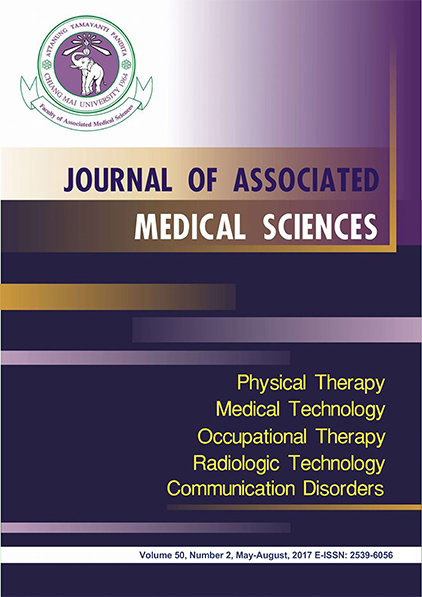Immediate effects of cold on balance and proprioception in Thai healthy older adults
Main Article Content
Abstract
Background: Cold has been commonly used to treat musculoskeletal injuries, especially in acute stage. However, there were some studies demonstrated that cold is temporarily affected on decreasing balance and proprioceptive performance in young adults which contribute to falling.
Objectives: To compare immediate effects of cold pack application and ice-water immersion on balance and proprioception in Thai healthy older adults.
Materials and methods: Fifty older adults were randomly assigned into 2 groups: cold pack group (n=25; mean age 68.80±6.09 years; 5 males; 20 females) and ice-water immersion group (n=25; mean age 69.65±5.90 years; 8 males; 17 females). All participants were seated on chair and received cold application over 15 minutes. At pre-and post-cooling, all participants were evaluated for their proprioception, static and dynamic balance by ankle joint position test, single leg stance test, and tandem walk test, respectively. Wilcoxon signed rank test was used to compare the differences of each outcome variable between pre- and post-cooling within group. Significance level was set at p<0.05.
Results: At post-cooling, the ice-water immersion group demonstrated a significant decrease in single leg stance time and increase in the number of missteps in tandem walk test compared to pre-cooling (p<0.05). The cold pack group showed a significant decrease in tandem walk test time at post-cooling compared to pre-cooling (p<0.05).
Conclusion: Applying cold pack did not effect on any outcome variables. Static and dynamic balance in Thai older adults was compromised after applying ice-water immersion. Fall risk cautions in Thai older adults should be taken when resuming an activity immediately such as walking and exercising after applying ice-water immersion on the ankle.
Journal of Associated Medical Sciences 2017; 50(2): 217-226. Doi: 10.14456/jams.2017.21
Article Details

This work is licensed under a Creative Commons Attribution-NonCommercial-NoDerivatives 4.0 International License.
Personal views expressed by the contributors in their articles are not necessarily those of the Journal of Associated Medical Sciences, Faculty of Associated Medical Sciences, Chiang Mai University.
References
2. Knight KL. Cryotherapy in sport injury management: Human kinetics publishers; 1995.
3. Stamford B. Giving injuries the cold treatment. Phys Sports Med 1996; 24: 99-100.
4. Hopper D, Whittington D, Davies J. Does ice immersion influence ankle joint position sense? Physiother Res Int 1997; 2: 223-36.
5. Fisher A. The effects of cryotherapy over the lateral ankles on static and dynamic balance [Master dissertation]. California: California University of Pennsylvania; 2009.
6. Kernozek TW, Greany JF, Anderson DR, Van Heel D, Youngdahl RL, Benesh BG, et al. The effect of immersion cryotherapy on medial-lateral postural sway variability in individuals with a lateral ankle sprain. Physiother Res Int 2008; 13: 107-18. doi: 10.1002/pri.
7. Douglas M, Bivens S, Pesterfield J, Clemson N, Castle W, Sole G, et al. Immediate effects of cryotherapy on static and dynamic balance. IJSPT 2013; 8: 9-14.
8. Pavol MJ. Detecting and understanding differences in postural sway: Focus on “a new interpretation of spontaneous sway measures based on a simple model of human postural control. J Neurolphysiol 2005; 93: 20-21.
9. Khanmohammadi R, Someh M, Ghafarinejad F. The effect of cryotherapy on the normal ankle joint position sense. Asian J Sports Med 2011; 2: 91-8.
10. LaRiviere J, Osternig L. The effect of ice immersion on joint position sense. J Sport Rehabil 1994; 3: 58-67. doi: https://dx.doi.org/10.1123/jsr.3.1.58.
11. Dewhurst S, Riches PE, De Vito G. Moderate alternations in lower limb muscle temperature do not affect postural stability during quiet standing in both young and older women. J Electromyogr Kinesiol 2007; 17: 292-98. doi:10.1016/j.jelekin.2006.03.002.
12. Jagga M, Lehri A, Verma SK. Effect of ageing and anthropometric measurements on nerve conduction velocity-A review. JESP 2011; 7: 1-10.
13. Taafee DR, Marcus R. Musculoskeletal health and the older adult. JRRD 2000; 37: 245-54.
14. Metzger D, Zwingmann C, Protz W, Jäckel WH. Whole-body cryotherapy in rehabilitation of patients with rheumatoid diseases--pilot study. Die Rehabilitation 2000; 39: 93-100.
15. Wongpakaran N, Wongpakaran T. Prevalence of major depressive disorders and suicide in long-term care facilities: A report from northern Thailand. Psychogeriatrics 2012; 12: 11-7. doi: 10.1111/j.1479-8301.2011.00383.x.
16. Ruiter CJ, Korte A, Schreven S, Haan A. Leg dominancy in relation to fast isometric torque production and squat jump height. Eur J Appl Physiol 2010; 108: 247-55. doi: 10.1007/s00421-009-1209-0
17. Michikawa T, Nishiwaki Y, Takebayashi T, Toyama Y. One-leg standing test for elderly populations. J Orthop Sci 2009; 14: 675-85. doi: 10.1007/s00776-009-1371-6.
18. Mayo Clinic Department of Neurology. Mayo Clinic Examinations in Neurology, 7th ed. Rochester, MN, Mayo Clinic Foundation, 1998.
19. Taechasubamorn T. Thermotherapy 1. Department of physical therapy, Associated Medical Sciences, Chiang Mai University; 1997: 35-45 (in Thai).
20. Kim KM, Hart JM, Saliba SA, Hertel J. Effects of focal ankle joint cooling on unipedal static balance in individuals with and without chronic ankle instability. Gait Posture 2015; 41: 282-87. doi: 10.1016/j.gaitpost.2014.10.017.
21. Uchio Y, Ochi M, Fujihara A, Adachi N, Iwasa J, Sakai Y. Cryotherapy influences joint laxity and position sense of the healthy knee joint. Arch Phys Med Rehab 2003; 84: 131-5. doi: 10.1053/apmr.2003.50074.
22. Kovaleski JE, Heitman RJ, Gurchiek LR, Hollis JM, Liu W, Pearsall AW. Joint stability characteristics of the ankle complex after lateral ligamentous injury, part I: a laboratory comparison using arthrometric measurement. J Athl Train 2014; 49: 192-7. doi: 10.4085/1062-6050-49.2.07.
23. Abramson DI, Chu LS, Tuck S Jr, Lee SW, Richardson G, Levin M. Effect of tissue temperature and blood flow on motor nerve conduction velocities. JAMA 1966; 198: 1082-8. doi: 10.1001/jama.1966.03110230098021.
24. Lee JM, Warren MP, Marson SM. Effects of ice immersion on nerve conduction velocity. Physiotherapy 1978; 64: 2-6.
25. De Jesus PV, Hausmanowa-petrusewicz I, Barchi RL. The effect of cold on nerve conduction of human slow and fast nerve fibers. Neurology 1973; 23: 1182-9.
26. Cameron MH. Physical agents in rehabilitation: From research to practice. Philadelphia: WB Saunders 2003, p: 140.
27. Chesterton LS, Foster NE, Ross L. Skin temperature response to Cryotherapy. Arch Phys Med Rehabil 2003; 83: 543-9. doi: https://dx.doi.org/10.1053/apmr.2002.30926.


